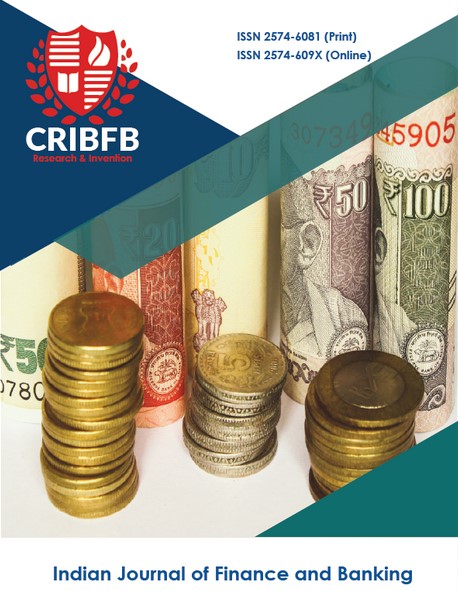The Impact of COVID-19 Pandemic on the Relationship between India’s Volatility Index and Nifty 50 Returns
Main Article Content
Abstract
The paper intends to re-examine the relationship between India’s Implied Volatility Index (IVIX) and Nifty 50 Returns during this COVID-19 pandemic. The study results are important for two reasons, one is to understand whether Indian VIX is fulfilling the purpose of measuring the near future volatility of Nifty 50 during this pandemic, and secondly, it reports the impact of COVID-19 on the investors’ perceptions about the returns and its volatility. The study results documented that the Nifty return and IVIX are moving independently during the COVID-19 pandemic and there is no association between market size and the market move. The one period lagged Nifty returns have a significant influence on the future market volatility. The combined impact of negative and positive Nifty returns on IVIX is not significant during the COVID-19 period. This implies that the Indian investors are not much worried about the fluctuation in the market price or size of the market during the COVID-19 pandemic period. The investors might be taking the market decline as an opportunity to invest and market rise as an opportunity to sell the stocks. Indian investors are much focused on the fundamentals than the market movements during this pandemic. The study results are important for the fund managers, policymakers, and analysts to understand the dynamics of emerging market volatility and the trading behavior of Indian investors.
Downloads
Article Details
Section
How to Cite
References
Black, F. (1976). Studies of stock market volatility changes. 1976 Proceedings of the American Statistical Association Business and Economic Statistics Section.
Campbell, J. Y., & Hentschel, L. (1992). No news is good news: An asymmetric model of changing volatility in stock returns. Journal of Financial Economics 31, 281–318.
Chakrabarti, P., & Kumar, K. K. (2020). High-Frequency Return-Implied Volatility Relationship: Empirical Evidence from Nifty and India VIX. The Journal of Developing Areas, 54(3).
Chandra, A., & Thenmozhi, M. (2015). On asymmetric relationship of India volatility index (India VIX) with stock market return and risk management. Decision, 42(1), 33-55.
Chen, A. H., & Siems, T. F. (2004). The effects of terrorism on global capital markets. European journal of political economy, 20(2), 349-366.
Chen, M. H., Jang, S. S., & Kim, W. G. (2007). The impact of the SARS outbreak on Taiwanese hotel stock performance: an event-study approach. International Journal of Hospitality Management, 26(1), 200-212.
Dhanaiah, G., Reddy, D. R., & Prasad, T. N. L. (2012). India VIX: Examining the negative and asymmetric volatility index – market return relationship. Indian Journal of Finance, 6(5), 4-10.
Fleming, J., Ostdiek, B., & Whaley, R. E. (1995). Predicting stock market volatility: A new measure. Journal of Futures Markets, 15(3), 265-302.
Fousekis, P. (2020). Sign and size asymmetry in the stock returns-implied volatility relationship. The Journal of Economic Asymmetries, 21, e00162.
French, K. R., Schwert, G. W., & Stambaugh, R. F. (1987). Expected stock returns and volatility. Journal of financial Economics, 19(1), 3.
Frijns, B., Tallau, C., & Tourani-Rad, A. (2010). Australian implied volatility index. JASSA, (1), 31.
Hibbert, A. M., Daigler, R. T., & Dupoyet, B. (2008). A behavioral explanation for the negative asymmetric return–volatility relation. Journal of Banking & Finance, 32(10), 2254-2266.
Kudryavtsev, A. (2017). VIX Index and Stock Returns Following Large Price Moves. Journal of Risk & Control, 4(1), 71-101.
Merton, R. C. (1973a). An intertemporal capital asset pricing model. Econometrica: Journal of the Econometric Society, 867-887.
Merton, R. C. (1973b). Theory of rational option pricing. The Bell Journal of economics and management science, 141-183.
Papakyriakou, P., Sakkas, A., & Taoushianis, Z. (2019). The impact of terrorist attacks in G7 countries on international stock markets and the role of investor sentiment. Journal of International Financial Markets, Institutions and Money, 61, 143-160.
Shaikh, I., & Padhi, P. (2015). On the Relationship of Ex-ante and Ex-post Volatility: A Sub-period Analysis of S&P CNX Nifty Index Options. Journal of Emerging Market Finance, 14(2), 140-175.
Siddiqui, S., & Roy, P. (2019). Asymmetric relationship between implied volatility, index returns and trading volume: an application of quantile regression model. Decision 46, 239–252 (2019). https://doi.org/10.1007/s40622-019-00218-5
Skiadopoulos, G. (2004). The Greek implied volatility index: construction and properties. Applied Financial Economics, 14(16), 1187-1196.
Whaley, R. E. (2009). Understanding the VIX. The Journal of Portfolio Management 35, 98–105.




